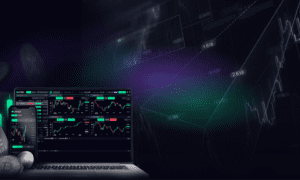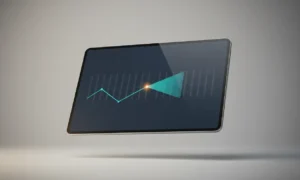In 2020, brick-and-mortar retail stores were believed to be on the brink of disaster. Right after the pandemic had burst into our lives, global retail sales fell by 2.9 percent. That was the time when people believed online shopping, omnichannel retail, and delivery services would fully replace brick-and-mortar retailers.
Yet, in-store shopping is not dead. We’re witnessing quite the opposite: global retail sales battled through the pandemic, growing from around $23.7 trillion in 2020 up to $27.3 trillion in 2022. Moreover, they’ll continue to increase, reaching $31 trillion by 2025.
However, in the age of all-embracing digitalization, you have more chances to get into this competitive industry and have a profitable business if you bring technology into your brick-and-mortar store. We’ve asked Alexey Shalimov, CEO at Eastern Peak, about how retailers can benefit from technological innovation, and he wants to share his opinion on that.
Alexey has founded several tech companies and has vast experience in introducing digital innovation to enterprises of all sizes in many branches. For the last 12 years, together with the Eastern Peak team of more than 250 engineers, designers and architects, he’s been helping companies across the globe keep up with tech trends and thus remain competitive in the market.
Alexey is convinced that technology can be beneficial for businesses in nearly any branch, and the retail industry is not an exception. Here, he’ll share his thoughts on the ways a brick-and-mortar retailer can leverage technology and transform the future of shopping.
Strategies for brick-and-mortar stores to embrace digital innovation
In-store cameras and sensors for tracking the customer journey
People have been talking a lot about tracking and predicting customer behavior in online stores. But is it even relevant for brick-and-mortar businesses? Indeed, modern retail technology is bridging online and offline selling practices to help retailers plan their inventory, stick to a customer-oriented approach, and improve the overall service.
Brick-and-mortar stores can benefit immensely from implementing new technology to get a closer look at what their visitors prefer and predict their preferences and shopping patterns in the future. Since customers have different ways of shopping, you can adapt your retail brick-and-mortar store to reflect these differences in consumer behaviors. For instance, you can manage bundled secondary placement for visitors who come into the store with a specific purpose. And for those visitors who spend much time walking around the shelves, retailers can send targeted recommendations or reminders for often forgotten products.
Observing customer decisions: Product interaction at the shelves
In brick-and-mortar retail, there are several ways to track the in-store shopping experience of the customers. One of them is installing cameras and sensors on the shelves and ceilings. They detect customers’ interaction with specific sections and products, for instance, how often they approach a shelf and which items they take or abandon.
Based on this data, dedicated algorithms can give you insight into the popularity of some products, the needs and preferences of your customers, and much more. At a more advanced level, these technologies can calculate the purchase amount, thus contributing to a faster and more comfortable checkout process.
Recognizing customers’ faces and automatic detection of emotional states
The future brick-and-mortar technology shopping experience is for the most part based on data collection and analysis. This approach aims at understanding customers and striving to give them what they really need. And how can you understand a human being better, if not by looking into the eyes?
If you combine advanced cameras with analytic algorithms, you will get an in depth, detailed picture of your customers and their preferences. Present-day tracking technologies can identify the age, gender, and other socio demographic features of the customer for you to adapt your strategy to your actual audience. What’s more, face recognition and eye-tracking technologies reveal information on the psychological state of the customers, assessing their judgments or even more complex emotions such as confusion or the need for consultation.
Technology for store inventory
Brick-and-mortar retail tech can assist store workers by bringing product tracking and management to a new level. IoT cameras and sensors, as well as artificial intelligence, detect the current location of the in-store items, helping employees notice when they need to restock inventory or just put the items in the correct place. Not only does it help to keep things in order in your brick-and-mortar store, but it can also assist in preventing thefts.
If we take a step further, we can also mention the predictive potential of AI that helps anticipate future shopping trends and restock the shelves with the most popular products. It will help store owners leverage long-term plans for their inventory in a way that brings the most profit and a stronger reputation.
For example, at Eastern Peak, we’ve leveraged the power of the Internet of Things to develop the Wiliot app, a platform for tracking in-store assets. It’s connected to the Wiliot tags that gather information about product location, condition, as well as the surrounding temperature and pressure. Store managers can find this data in a secure cloud, so you always have access to all your assets in one app.
VR & AR
By integrating technologies into your physical store, you can transform even the most familiar things that shape the whole shopping experience. In this context, AR and VR prove that the effects of technology on brick and mortar can be as significant as in other kinds of businesses. The range of applications of this type of technology is huge, from allowing customers to get more information about a specific product to assisting interior designers in planning the store layout effectively.
Besides that, virtual and augmented reality can turn fitting rooms into a fun and exciting experience while helping visitors make a more informed shopping decision. It can appear in the form of digital fitting rooms, similar to a try-before-you-buy application. You can also bring technological innovation into a smart mirror that can set the desired time of the day, lightning, or location, so customers can have an image of how the thing works in different settings.
Smart checkout & line management
Long lines are an infamous feature of brick-and-mortar shopping. It’s arguably among the main reasons why increasingly more people choose to buy things online instead of spending time in physical stores. Fortunately, new technology aims at eliminating lines per se, thus taking brick-and-mortar experiences to a new level.
To make customers forget about spending their time in lines, store owners should consider improving their checkout system. One of the most popular methods so far is implementing several payment options, including contactless payments, to make the checkout process almost instantaneous. Self-checkout stations allow people to move at their own pace without interacting with the store staff.
You can also replace barcodes with smart scanning systems that can identify items and calculate the price automatically and much faster than traditional checkout. Also, sending digital receipts can save not only customers’ time but also the planet’s resources. Another option is to offer product delivery options, so customers can pay for their goods in-store and then get them shipped to their address.
You can make the checkout process fast and seamless by leveraging the power of digital technologies. It will surely make in-store shopping a more convenient and pleasant option for your customers.
Self-service technologies
The future of shopping will most likely look very different from what we see now: no long lines, less staff, and a more thought-out store design for customers to navigate the store on their own. A lot of that is real today, as many stores give their customers a choice to order specific products on the automated ordering stations, explore the items with the help of AR and VR, and pay for the chosen products instantly.
At the same time, the future of brick-and-mortar will also look different for store owners. By investing in retail technology, they can cut costs on staff, as much of the work will get automated and performed by the store visitors. Simultaneously, it will likely increase profits drastically.
QR codes
Nowadays, QR codes are not a novelty anymore. Scanning a black squared code is quite a simple procedure, but still, it has brought benefits to many business branches. After the pandemic, QR codes have become a common thing wherever you go, as it’s one of the factors that helps avoid unnecessary human contact. However, even in post-pandemic times, this technology will surely remain relevant and widespread.
Retailers usually leverage the power of QR codes diversely. The customers can use them to see the product catalog or detailed info about a certain item, pay for goods, learn about new deals and news, leave feedback, complete a quick survey, or simply practice social distancing. Whatever you may choose, this will make customers’ interaction with your brick-and-mortar retail store more enjoyable.
The lessons for brands
Integrating technologies into your physical store is an important milestone in your business journey that requires a significant shift in the way your shop does business, as well as in your mindset. So, it’s a great idea to build a strategy to get the most out of your business transformation.
Here are three points you might want to consider before investing in retail technology.
The future of shopping is neither all offline, nor all online
In the last decades, and especially in the last several years, online stores and delivery services represent a huge competitor to brick-and-mortar retail stores. However, it doesn’t mean traditional offline stores are sinking into oblivion. They embrace digital innovation more and more, erasing the service quality between online and offline shopping. Today, customers don’t need to choose between the convenience of online shopping and the experience and service of brick-and-mortar retail. They can go whichever way they want and enjoy an excellent shopping experience either way.
Deliver technology with customers at the center
If a brick-and-mortar retail business chooses a data and tech-driven approach, it will work only if it’s oriented toward their customers. That means you need to implement the right technologies based on the needs and concerns of your target audience. Collect customers’ data, analyze the way your customers interact with your business, appreciate their feedback, and then leverage the power of digital transformation to make your store the best choice for your customers.
Consider partnering with a reliable technology provider
All the available technological means can inspire businesses for groundbreaking initiatives. However, it’s crucial to have an experienced partner who knows how to embody those concepts into an actionable project. In this respect, partnering with a technology provider will bring about fruitful cooperation for a brick-and-mortar retailer. A reliable tech company can support business initiatives and understand them at the highest level, guided by the individual goals of the given retail company.
Wrapping up
The rise of online shopping will not endanger the future of brick-and-mortar retailers. On the contrary, the technological advancements that gave birth to all benefits of online shopping also serve the brick-and-mortar industry. In the following years, retail will represent the combination of a physical and digital space, powered by digital technology in-store, such as AR, VR, IoT, AI, and more.



































